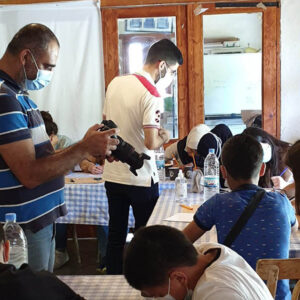Bible storytelling is a skill that most of us are not born with. It’s hard the first time but will get easier the more stories you learn. Here is the basic process.
Learn the story
- Choose a story of between 5-15 verses. We suggest you start on the first of the Bible overview set of stories (Genesis 3:1-15).
- Read the entire story out loud, slowly and clearly. I suggest you use a modern version of the Bible. Why ‘out loud?’ Iit helps you listen and really notice the story
- Close the Bible (or cover the screen) and tell the story out loud. Just tell it as well as you can. This first time you will make many mistakes and miss many of the details. Don’t worry. Your mistakes mean that you’ll pay more attention next time you read it.
- Read it out loud again and then tell it out loud again. Repeat step four as often as you need to. I find I usually need at least three times.
Prepare the introduction
Once your story is learned then ask yourself, “What information does my listener need to know to understand the story?”
Some of the things to include:
- Real time, real people, real place – put the story in it’s context. For example, “Abraham was a man who lived 4000 years ago in a place called Babylon which is in the area we now call Iraq.”
- Define any terms that might come up in the story. For example, ’Sabbath’, ‘Pharisees,’ ‘temple,’ or ’synagogue.’
- You might need to explain a cultural point like a marriage custom or job (like a ‘tax collector’ and why they were hated).
- You might need to bridge from the previous story to show the link. I often use the phrase, “And Adam had children and their children had children and many generations passed… one descendant was a man called Abraham…”
- You might like to ask a question that gets people thinking and wanting to hear your story. For example, I often ask, “Look at this world around us, it’s so beautiful, have you ever wondered where it came from?” and then, “The world is so beautiful but there is also so much pain and suffering, have you ever wondered why? What do you think?” After listening to them, I’ll say, “I have a story that begins to answer these questions.”
Actually telling your story
It is important to differentiate between your introduction and the actual story. This can be done in many ways.
- You can say, “Before I tell the story, I will first introduce it. This is the introduction (give your introduction).” Then when it is time for the story say, “This is today’s story (and then tell your story).” At the end of the story say, “That is the end of the story.”
- Some people indicate the different sections with an action. That is, they might always open a Bible at the start of the story and lay it aside, still open, on a stand/table and then close it at the end of the story.
- Some people use a hand action.
Choose the approach that suits your context.
« A New Day in India Listening to the Gospel in North Korea »










